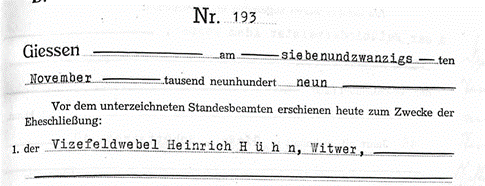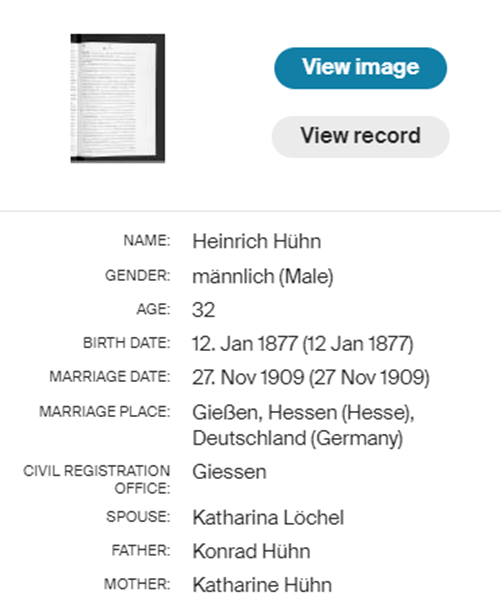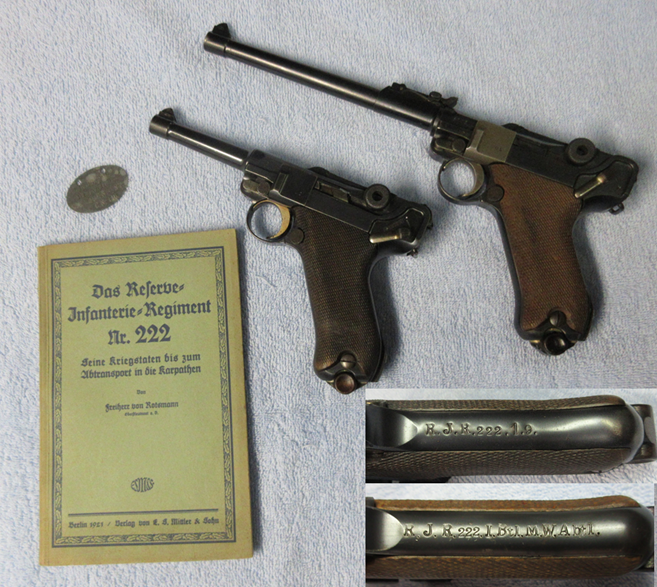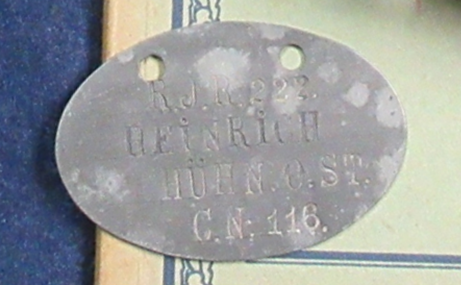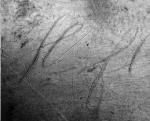
JohnBurke
Past Contributor-
Posts
35 -
Joined
-
Last visited
Content Type
Profiles
Forums
Blogs
Gallery
Events
Store
Everything posted by JohnBurke
-
Andy, Just a few more thoughts to tie up our forum discussion. I was a military analyst and often had to speculate or “look between the lines” to interpret available intelligence and match it with physical evidence. And much like in detective work, some “facts” are often only circumstantial evidence. Our research here has led us to make the connections between Heinrich Hühn, his rank of Visefeldwebel, his job position (O. ST.), his marriage in Giessen Hessen, and with the 1. Ersatz Bataillon Inf. Reg. 116 also located in Giessen. Also, it was a matter of record that the Bataillon was tapped to provide staff as well as 1st and 3rd companies to fill the ranks of R.J.R.222. So, the physical ID tag with Heinrich Huhn’s name and “R.J.R.222.” stamp ties him directly to both R.J.R.222 and 1. EB IR 116. As someone who has studied unit marks, if there is no “qualifier” as to company, for example, RJR222.1 or RIR222 1.K. showing connection to 1st company, it normally means the stamp represents an item issued to the “stab” or “staff.” In this case, we know that 1. Ersatz Bataillon Inf. Reg 116 contributed members of its 1st Battalion staff, 1st Company, and 3rd Company to R.J.R.222. Hühn chose only to put “R.J.R.222.” on his ID tag and did not specify a company (in this case either 1st or 3rd Company). This leads one to think that Hühn was assigned to R.J.R.222 1st Bataillon staff or the Regiment staff and not specifically to a company. Also, he chose not to include his actual rank Visefeldwebel (or Vfw.) on his ID tag. Instead, he puts his job positional title of “O. ST.” or Stellvertreter. Why was that? So, it comes down to the question of the meaning of “C.N: 116.” We have mentioned that it could mean “Compagnie-Nummer:” wherein the word “Compagnie” might be spelled with a “C” instead of a “K”. Thus giving the possibility that the number “116” is just the company “serial number” of his ID tag. But given the fact that Hühn chose to use his title “O. ST.” over his rank (Vfw.) on his ID tag, it seems perfectly logical that he might also specify what his job actually was on his ID tag. In addition, it seems much more than a simple coincidence that the suspected company number “116” matches with IR 116 Ersatz Battalion regimental number. This brings us back to the original question about the meaning of “C.N:” itself. It now begins to make more sense that “C.N: 116.” refers to Hühn’s job description on the staff of R.J.R.222. Also he wanted to maintain the connection to his original Bataillon as some reassigned soldiers often did. I have mentioned that “C.N:” could be the abbreviation for "Chef des Nachrichtenwesens: 116." or "C.N: 116." meaning "Director of Signals: Inf. Reg. 116" or “Director of Intelligence: Inf. Reg. 116”. In more modern terms one could say “Director of Communications with Inf. Reg. 116.” or “Director of Intelligence from Inf. Reg. 116”. I read somewhere that an active front line Imperial German infantry regiment would require about 2 companies in training per month in order to provide replacements for lost personnel (KIA, wounded, sick, leave) from the regiment. Wouldn't it make sense that someone on the R.J.R.222 staff was responsible for maintaining communication with the Ersatz (replacement) Bataillon to keep up with the flow of needed replacements? And that person could have been Offizier Stellvertreter (O. ST.) (Vfw.) Heinrich Hühn C.N:116. How's that for connecting the dots? Cheers, John
-
Andy, OK, very good. Based on what you told me I took a slightly different tact and looked on Ancestry.com. I think I found Vizefeldwebel Heinrich Hühn's marriage records and birth record as follows: Born: 12 Jan 1877 Llershausen Hessen; Married twice: First time on 24 Dec 1904 to Katharina Margarett Engle who apparently died; As a widower, he remarried again on 27 Nov 1909 to Katharina Löchel. Place of Second Marriage: Gießen, Hessen; His parents: father Konrad Hühn, mother Katarine Hühn. The give away in this research was in the second marriage certificate it lists his rank as "Vizefeldwebel". Also, the place of marriage, "Gießen, Hessen", would have been where the 1. Ersatz-Bataillon Inf.-Rgt. Nr.116 was located. His birth date matches on all records. So, putting two and two together, he must have been in the 1st battalion's staff or first company or third company which went to become part of R.I.R.222 and were he took on the duty position of Offizier-Stellvertreter as indicated on his ID tag. Also, he was in military service as early as 1909 but probably before that. Only bad news, no specific military records found on him so far. Also, I have not found him on a military death or seriously wounded list yet so he must have survived the war relatively unscathed. Cheer, John
-
Andy, Yes, I have a copy too and, you are right, it doesn't have much in it. Too bad. I was thinking the Hühn may have come from 1. Ersatz-Bataillon Inf.-Rgt. Nr.116 aufgestellt in Giessen 1. & 3. Komp. (als 1. & 3. Komp.) zum Res.-Inf.-Rgt. Nr.222. There is a regimental history book "Geschichte des Infanterie-Regiments Kaiser Wilhelm (2. Grossherzoglich Hessisches) Nr. 116." I don't have a copy of it and I'm not sure it would contain a members list for their 1. Ersatz Bataillon. But you never know unless you look. If someone you know does have a copy, maybe they could have a look inside to see if Hühn is listed. I did find a reference to a Heinrich Hühn at: https://www.gelsenkirchen.de/de/bildung/ausserschulische_bildung/institut_fuer_stadtgeschichte/_doc/Gefallenenregister_WK_I_final.pdf Hühn Heinrich Born 09.05.1896 Schrök Rank: Musketier Killed: 15.06.1916 vor Verdun But I don't think that can be him because that soldier was a "musketier" who was killed and not a Offizier-Stellvertreter. Also no regiment was given. Cheers, John
-
Andy, Thank you for clarification about the use of "C" versus "K". I think "Compagnie-Nummer:" actually makes most sense. Now, I wonder if there is info about O. ST. Heinrich Hühn himself? Other than his ID tag, I haven't found a reference that connects him to the R.J.R.222. His regiment's actions can be inferred by the operations of the 96. Reserve Infanterie Brigade under 48. Reserve Infanterie Division. The regiment participated on both the Western and Eastern Fronts. The regiment ended the war on the Western Front fighting against the 3rd Canadian Division. Below is the Hühn's ID tag included as a part of a small grouping of related items. The regimental history book covers only regimental activity in 1914 and Hühn's name is not mentioned within. Cheers, John
-
Here's another thought. How about "Chef des Nachrichtenwesens: 116." or "C.N: 116." meaning "Director of Signals Inf. Reg. 116" ? The two letters before the number indicate that it might not simply be a "dog tag" serial number or ID serial number. But why this soldier would include that on his ID tag is somewhat of a mystery. I found the above expression in the General Staff (Intelligence) General Headquarters book entitled "Vocabulary of German Military Terms and Abbreviations" dated July 1918. The only way to confirm that interpretation would be to know more about O.ST. Heinrich Hühn's R.J.R.222. or I.R.116. actual job description. Other ideas?
-
Andy, Thanks for responding. I've attached a close up of the "C.N: 116." I see now that there is a colon after the letter "N". To me, it looks more like a "C" and not a "G". Its not "Confederate Navy"! I was thinking that it might be related to Inf.Rgt.116 as well. I think the "N" might mean "nummer" but most of the English words that I can think of beginning with the letter "C" translate to a "K" in German. Any other ideas?
-
Hello Fellow Members, Below is my Imperial German Dog Tag for Offizier-Stellvertreter (“O.St.”) Heinrich Hühn. He was in Reserve Infanterie-Regiment Nr. 222 (R.J.R.222.) I'm not sure of the meaning for "C.N.116." which also appears on the tag. Reserve-Infanterie-Regiment Nr. 222 was raised in Gießen (regimental staff and 1st Battalion from the replacement battalion of Infanterie-Regiment Nr. 116) and Mainz (2nd Battalion from the replacement battalion of Infanterie-Regiment Nr. 88, 3rd Battalion from the replacement battalion of Infanterie-Regiment Nr. 117). I haven't had much luck finding out any further details about this man but would like to know more about him if something exists. Thanks, John
-
Hello Ed, Nice rig. Got your message. I would suggest checking to see if IR 186 published a regimental history. Some regiments did, some did not. If they did and you can read German, you might find some information about the MWA assigned to them. Sometimes there will be a description of the action in which the MWA was employed. There may be members who have copies of that regimental history or they can tell you where you can get a copy. Good luck.
-
Fellow Colleagues, For those interested, I wanted to update my post since I've had some messages from other members of the GMIC. The responses were that the first letter of the script looks like a German current style script letter "H". So the inscrption on the EK1 back is "H. Flesche". This rules out owners Ltn. Alfred Flesche (I had this name wrong as Albert in my first post) and Ltn. Erich Flesche listed in the 1926 Prussian Army Rankliste as members of FAR 67. The other soldier found in the 1919 Prussian Army Reserve Rankliste was Ltn. d. Res. Flesche of the 2. GDzF. Glenn Jewison, moderator from another GMIC topic, wrote with the following information - "The Leutnant d. R. Flesche in 2.GRzF was Hermann Flesche. He additionally won a Knights' Cross 2nd Class of the Baden Order of the Zahringer Lion with Swords on 5 September 1916. He survived the war. He is shown as a member of 2. GRzF at the time of his award of the BZ3aX. Hermann Flesche's award of the Zähringer Lion is listed in Erhard Roth's "Verleihungen von militärischen Orden und Ehrenzeichen des Großherzogtums Baden im Ersten Weltkrieg 1914 – 1918" I am continuing to browse a copy of 2. GRzF regimental history book by Friedrich Wilhelm von Rieben: "Das 2. Garde-Regiment zu Fuß" - Zeulenroda 1934, Sporn, 639 Seiten. If anyone has additional information about Ltn. d. R. Flesche I would be interested in hearing from you. Sincerely, John
-
Dear Fellow Colleagues, I have an EK1 with a hand scribed name on the back as shown in the pictures below. It is "KO" marked on the back as well. Myself and a few others discussed what we saw on the back and we at first thought that the inscription read "H. Flesche" This is not a common name. With this information we looked in the 1918 Rankliste and found a solder by that name who served in FAR 67 from 1914 thru 1918. The FAR 67 regimental history book was obtained. In the book, we found that the soldier was in fact awarded the EK1 on 3 Nov 1918. In the 1918 Rankliste we saw he was promoted to Oblt on 10 Nov 1918. The rub comes when we look at the letter "H" in the inscription. Some feel we got it wrong, it is not a letter "H" but some other letter(s) such as "Lt" or perhaps a fancy "A". We noted every line and pen stroke and tried to compared it with current style German script. Indeed it might be some other letter but we cannot come to a consensus. Another rub came when looked in the 1926 Rankliste (covering the period 1914-1918), all of a sudden there were two Flesche officers listed in the same regiment - Albert and Erich. Neither having a name beginning with a letter H. The letter A would make sense, since Albert Flesche was shown to be in the 31st Infantry Division to which the FAR 67 was assigned throughout WWI. The regiment's history book mentions only one Ltn Flesche with no first name given. So how could a regimental history book get it wrong? I tend to think not. Can someone look at the inscription below and offer their an opinion about it what it says? What is the first letter or letter(s) in your opinion. A close up provided. At first glance is does look like an H but if you look deeply into the script and the specific pen strokes, there can be some doubt. Also, who is this guy? Any other insight would be appreciated. Thanks, John
-
Gentleman, Can anyone provide a photo of Austrian General Albert Freiherr von Koller wearing his uniform overcoat? I already have the head shot photo shown below. I'm specifically looking to find a full length photo of him wearing his overcoat in the rank of General. I would be very grateful if someone can come up with that photo or perhaps knows a place I can contact to get one. For anyone interested, a great summary of his distinguished career and decorations can be found at: http://www.austro-hu...biog/koller.htm Assistance appreciated. Thanks, John.
-
Davin, OK, I can see the unit marking more clearly now. What you have is the following unit mark: M.W.A.L.I.R.382.2B.38.. So your gun (at least the main frame of the pistol) belonged to a 1917 P08 lange issued by Minenwerfer-Abteilung, Landwehr-Infanterie-Regiment 382, Second Bataillon as Waffe no. 38. On the Jan Still Gunboards web site at the before mentioned link you will see a complete 1917 P08 Lange ser nr. 6713c having the unit mark M.W.A.L.I.R.382.2B.4. and so the frame of your gun was just a few numbers off in the weapon number. Very good. Best, John
-
Daven, Thank you for posting addition information about you MWALIR unit marked P08. I think your pistol unit mark is M.W.A.L.I.R.382.1.B.38. Your picture at the indicated site is not so clear but if the numbers you indicate are accurate than that's what I think you have in the way of a unit marking. With a better picture of the grip strap I think I can help you further. I think you are correct about the barrel replacement as these should be the long barrel. All the ones known were issued to this unit were 1917 dated P08 lange. There is also discussion on Jan Still's gun boards web site at http://luger.gunboards.com/showthread.php?t=22859 . You will need to join as a member to see the pictures posted. I can tell you that there is another unit marked P08 known to exist with a marking similar to yours: M.W.A.L.J.R.382. 1.B.10. which means Minenwerfer-Abteilung, Landwehr-Infanterie-Regiment 382, First Bataillon Waffe no. 10. Yours would be weapon number 38 and would have the "38" vice the "10". Counting your unit marked P08, there are is four known P08s from the M.W.A.L.I.R.382. Two from 1st Batailion, one from 2nd Batailion, and one from 3rd Batailion. I would also say your serial number is in the "c" series (SN 3791c) and therefore not too far off from the other 1st batailion serial number (sn 6207c). I am still wanting to know more about this unit as a whole. Interesting discussion. Again thanks for adding to it. Best, John
-
Erick, Thanks so much for posting my pictures and comparisons. I think we are all in agreement that the EK1s are from Infantry Regiment 56. Also, it looks like the engraving on both medals might have been done by the same engraver. There is more to the Ltn d R Enger story and it is contained in the regimental history book. He is mentioned two other times in the text of the book. I'm going to get those sections translated and will post my findings. Apparently he was in charge of a MW unit and involved in a stormtroop assault. The book appears to cover the action in some detail. So more to follow in that regard. Also, I looked up the 14th Division in 250 German Divisions to which the IR 56 was assigned throughout the war. This division was assessed as a good division by US intelligence and the 1st French Army commented on Jan 18, 1918 in a note that the division "is a division destined to attack." For most of 1917, the division was involved at Chemin Des Dames and was engaged in the Flirey sector just before being relieved on 13 Jan 1918. It was noted that they sustained very heavy losses with many prisoners and that much of the division was decimated by French artillery. Ltn Enger was awarded his EK1 on 22 Jan 18 just a few days after his unit was relieved in the Flirey sector (east of St. Mihiel) by the 78th Reserve Division. So the date on the award would make a lot of sense. John
-
Dear Colleagues, Can anyone help me with additional information on the subject named German Officer? He was awarded his EK1 on Jan 22, 1918. My initial research on this man is described below; however I have limited resources. Any additional information about this officer would be greatly appreciated. The EK1 is engraved in script to a Leutn/d Res. Enger, F.R 56, 22.1.18, Kriegsjahr/1918. According to one of my references, Imperial German Headgear (1888-1914), Infanterie-Regiment Nr.56 (7. Westfallsches) Third Bataillon was Fusilier. So I presume the unit mark "F.R. 56" would be for the Infanterie-Regiment Nr. 56 III Bataillon. I have done some preliminary research in the 1914 German Reserve Officer Rankliste and the Ehrenliste 1914-1919 published in 1926 but I can find no officer active or reserve from any regiment by the name of Enger. On the internet I found that in 1914 the 14th Infantry Division, 79. Infanterie-Brigade, was composed of the following regiments: Infanterie-Regiment Freiherr von Sparr (3. Westfälisches) Nr. 16 Infanterie-Regiment Vogel von Falkenstein (7. Westfälisches) Nr. 56 Infanterie-Regiment Herzog Ferdinand von Braunschweig (8. Westfälisches) Nr. 57 Also in that same year the following was found for IR 56: III. Bataillon Bataillons-Kommandeur: Major Zöllner Bataillons-Adjutant: Leutnant Josef Harpe Bataillons-Arzt: Stabsarzt der Reserve Dr. Brömel Assistenz-Arzt: Unterarzt der Reserve Dr. Löw Verpflegungsoffizier: Leutnant der Reserve Merkel Bataillons-Zahlmeister: Zahlmeister Rau Bataillons-Schreiber: Vizefeldwebel Pöler And under the 9. Kompanie for the III batailion: Kompanie-Chef: Oberleutnant Krätschell (v. I.R. 15) Leutnant der Reserve Dickmann Leutnant Schrepffer Offizierstellvertreter Conrads Offizierstellvertreter von Amelunxen Kompanie-Feldwebel: Feldwebel Engeler Note that the 9th Kompanie Feldwebel's name "Engeler." This is so very close to the name "Enger" on the award that I'm thinking there must be a typo in official records and they are the very same man. Of course the engraving must be the correct spelling. This would especially be true if some promotion record can be found showing the Feldwebel promoted to Ltn d Res. on or before the year 1918. I understand that there is a published regimental history of IR 56 and there may be limited edition gazettes that might have additional information about this particular German Reserve Office. These references I do not have. Any information that might help solve the mystery would be appreciated. Sincerely, John
-
Hello Christophe, Thanks so much for checking those references. Name spellings I found are so close! Perhaps another resource might have it? I believe it is authentic and an officer private purchase. If someone were savvy enough to authentically fake then they could of at least picked the name "Pitrof." because that would have been much better! And a P08 of this type probably worth more unmarked. Several knowledgeable colleagues have look at the marking and they think it genuine too. So I remain hopeful something will turn up. Police owned? Post-WWI? Other thoughts? Any other ideas for continuing the hunt appreciated. Sincerely, John
-
Hello GMIC members and fellow researchers, Attached is a picture of a name marked commercial P-08 with the name "Pitroff" stamped on the front grip strap. The style of the marking is undoubtedly like many unit marked pistols of the period and it is an authentic piece. I presume it was sold to a German Officer around 1907 based on the serial number and some other indicators. I might be wrong in that assumption but it is my initial assumption. I have searched available resources on the internet and in the 1914 Bavarian rankliste for some officer by the same name "Pitroff". If I read the documentation correctly, I have found only two names with very similar spellings but not the exact spellings; "Adam Pittroff" and "Daniel Pitrof" in the 21st and 20th Bavarian regiments respectively. I found that Adam Pittroff was KIA in 1916. And it would be great if the name on the P08 was "Pitrof" because that Bavarian officer went on to become a rather famous decorated hero. However, no such luck because the spellings do not match whats on the pistol. I'm ruling out a mispelling or a later date name change based on inputs from fellow German colleaques who insist that German name changes were not made and on the attention to detail maintained by German records keepers. I do believe the name is Bavarian based on some on-line genealogical databases that show current day Pitroffs living in Germany, specifically the areas of Kulmbach, Bayreuth, Forcheim, Bamber, and Hassberge with the majority of those living in the first two named places. And so, I'm wondering with the resources available to some of our fellow GMIC members if someone could come up with a German officer having a name to match to the name on the P08. I'd like to be able to continue researching my pistol further but have basically come to a dead end. Any help with this research would be greatly appreciated. I wish I could provide more information to start but that's as far as I'm presently able to go. Sincerely, John
-
Glenn, Great research and info! Thank you very much for providing key information about Herr Plessing. It proved the valuable link to discovering the history behind this EK1 and his connection to actions at Verdun. I will post a few pictures of the artifacts for members to see. They will observe an EK1 that has seen service. It is well worn and imperfect. Reviewing the engagements of the 54th Infantry Division following actions at Verdun, Herr Plessing was lucky to have survived the war and if he wore his award it explains the condition. I suspect that after the war he penned his modest note to an interested family member who kept it with the EK1. I have no idea what the structure of a Brigade Staff HQ would look like and wonder what his specific job might have been. Since he was a Hussar officer that might be a clue. I imagine the HQ had to be close enough to the combat to be hazardous duty. Certainly if the location was determined by the enemy it would be a priority target. Sincerely, John
-
Glenn, Based on your tip above, I was able to track down the following additional information on my EK1 recipient: From Wikipedia The Free Encylopedia: http://en.wikipedia.org/wiki/54th_Infantry_Division_(German_Empire) The 54th Infantry division was “formed on March 3, 1915 from units taken from other divisions or newly raised. Its infantry core was from different parts of the German Empire: the 27th Reserve Infantry Regiment from Prussian Saxony, taken from the 7th Reserve Division, the 84th Infantry Regiment from Schleswig-Holstein, taken from the 18th Infantry Division, and the 90th Reserve Infantry Regiment from the Grand Duchy of Mecklenburg-Schwerin, taken from the 18th Reserve Division.” “From May to November 1916, the division saw extensive action in the Battle of Verdun, especially in the fight for Fort Douaumont.” “The 54th Infantry Division's initial organization when formed in 1915 was as follows (Hermann Cron et al., Ruhmeshalle unserer alten Armee (Berlin, 1935) 108.Infanterie-Brigade Reserve-Infanterie-Regiment Nr. 27 Infanterie-Regiment von Manstein (1. Schleswigsches) Nr. 84 Großherzoglich Mecklenburgisches Reserve-Infanterie-Regiment Nr. 90 Radfahrer-Kompanie Nr. 54 1.Eskadron/Braunschweigisches Husaren-Regiment Nr. 17 54.Feldartillerie-Brigade Feldartillerie-Regiment Nr. 107 Feldartillerie-Regiment Nr. 108 Fußartillerie-Bataillon Nr. 54 Pionier-Kompanie Nr. 107 Pionier-Kompanie Nr. 108” From the Die Suchmaschine zum 1. Weltkrieg 1914-18 web site: http://www.1914-18.info/erster-weltkrieg.php?u=188 “54.Inf.Div.: 35.Inf.Brig. (18.Inf.Div.) wird aufgelöst. Stab/35.Inf.Brig. wird umbenannt zu Stab/108.Inf.Brig. Stab/108.Inf.Brig. mit Inf.Regt.84 von aufgelöster 35.Inf.Brig. (18.Inf.Div.) zu 108.Inf.Brig./54.Inf.Div.” Elements of the 18th Infantry Division, the staff of the 35. Infantry Brigade and IR 84 were reassigned to the 54th Infantry Division on June 3, 1915 as a part of the 108th Infantry Brigade. http://www.1914-18.info/erster-weltkrieg.php?u=188&info=54.Infanterie-Division&start=30 11.5.-9.9.1916: 54.Inf.Div.: Schlacht bei Verdun <A name=bid135133>18.-29.5.1916: 54.Inf.Div.: Kämpfe um Höhe 304 From Nov 5, 1915 through Sep 9, 1916, the 54th Infantry Division is involved with the Battle of Verdun. And from 18 to 29 May 1916 the division fights around hill 304! My Conclusions: The 54th Infantry Division was an active participant at Verdun in 1916 and at Hill 304. So your clue plus the additional information above provided the needed trail that links Oberleutnant d. R Plessing, HR 16, to Verdun 1916. Plessing must have been a staff officer on 108th Infantry Brigade (reassigned from the 35. Infantry Brigade) when he won award of his EK1. The date of his award was 9/9/16 which corresponds to the end of the 54th’s campaign at Verdun and at hill 304. This information matches with the date and info (for actions around hill 304) penned by Plessing himself on a note to accompany his EK1. The EK1 inscription bears the 9/9/16 date. (Plessing states in his note that Generalleutnant Watter presented him with the award.) So, the unit information researched above would tend to confirm information in the handwritten note (where, for what, and by whom the award was given) and in the inscription on the back of the EK1 (rank, name, rank, unit, date). My original thoughts were to trace elements of the HR 16 to Verdun which would have been a dead end. Actions at Hill 304 at the left flank of Verdun According to Wikipedia when frontal assaults on Verdun failed the Germans turned to the flank and attacked the west (left) bank of the Meuse river at the hills of Le Mort Homme on 6 March and Hill 304 on 20 Mar 16. The German artillery preparation was substantial and turned the hills into a quagmire of mud and rock. At great human and material cost, the German's eventually were able to occupy the crests of both hills and silence guns that had hindered progress towards Verdun and provided commanding views of the battlefield. Staff Officer Plessing must have been a part of this action. Thanks to you, Glenn. I have some pretty good info for the EK1. Sincerely, John
-
Hello GMIC members and fellow researchers, I have an EK1 award given to a Oberstleutnant des Reserves "Plessing" in Hussar Regiment No. 16 for his actions at Verdun hill 304. The award was presented by Generalleutnant Wetter on 9 Sep 1916. Reservist Plessing does appear in the 1914 Prussian Rankliste for Reserves as a Ltn and must have been promoted to Oberstleutnant sometime between 1914 and 1916 when he was presented with the award. Information provided with the award gives the specifics for the award but could be in error. I have looked in the usual references (Nolls and 250 German Divisions) for information about the HR 16 but the two references are inconsistent. I can find information on the whereabouts of the HR16 at 1914 mobilization and in 1917 & 1918. However, HR 16 and components are unlocated in 1915 and 1916. I have no information that would place any component of the HR16 on the Western Front between 1914 and 1916. I do not have the HR 16 regimental history book and so have no specific details on HR16 (or specific squadrons) location. Can anyone help me place a HR 16 reserves officer on the Western Front before Sep 1916 or specifically at Verdun in 1915/1916? Also, does anyone have information or pictures of a Generalleutnant Wetter awards ceremony on or about Sep 1916? Also, your direction to an appropriate reference work would be welcomed. Thanks for your help. Sincerely, John
-
Chris, I found a good summary of Landwehr establishment and MWA reorganization dates at the below link. It would appear that LIR 382 came into existance in 1915 even if the LD 44 had not, but I think the LD 44 was around too. Also, I don't believe the transition to MWKs happen overnight. Perhaps I read the footnotes incorrectly, but some MWA may have existed beyond 1916. John http://www.agw14-18.de/formgesch/formatio_...in.html#_ftn107
-
I wouldn't get too hung up on trying to figure out if the unit mark is correct or not. There was plenty of non-standard marking going on at the time. I'm certain the marking is original and non-standard. One man's department or detachment was another man's company when it came to unit marks. I'm still after information about the L.I.R 382 and what MW units might have been assigned to it. Thanks, John


